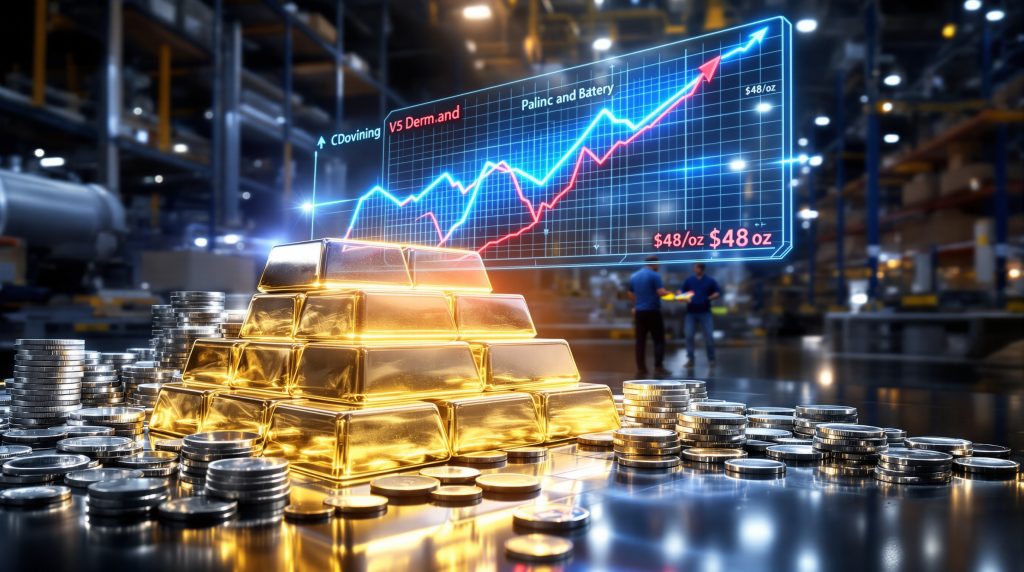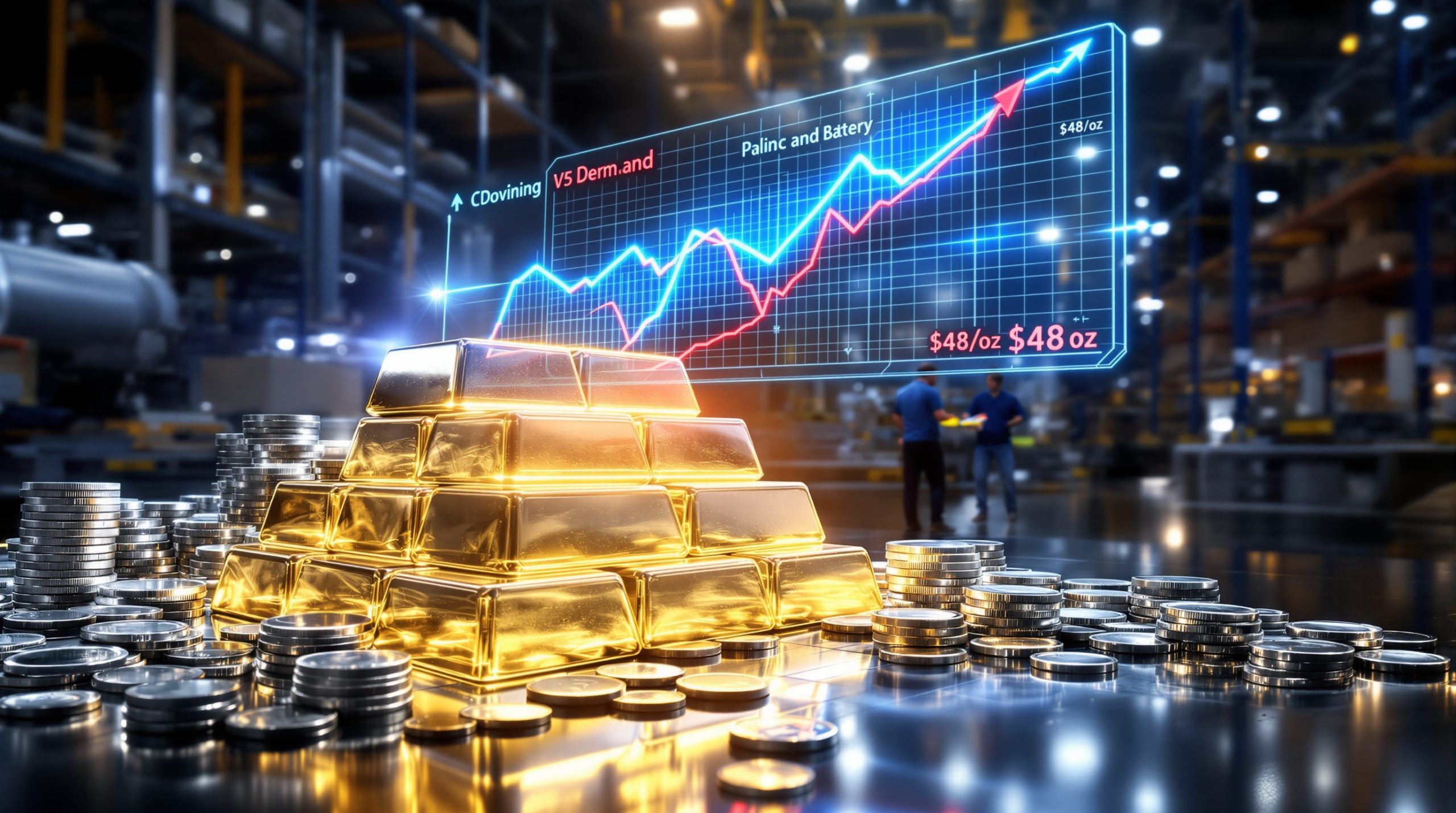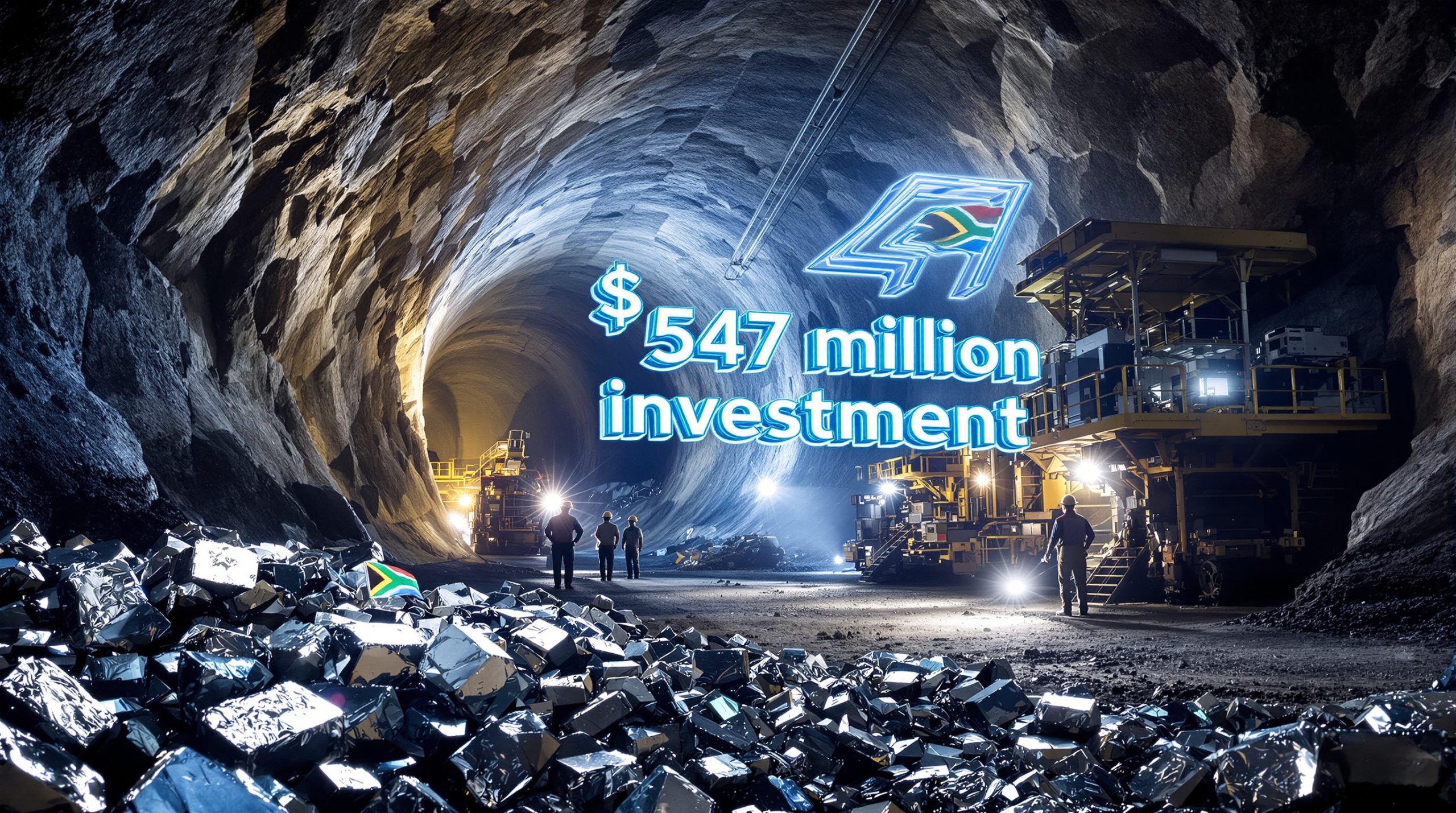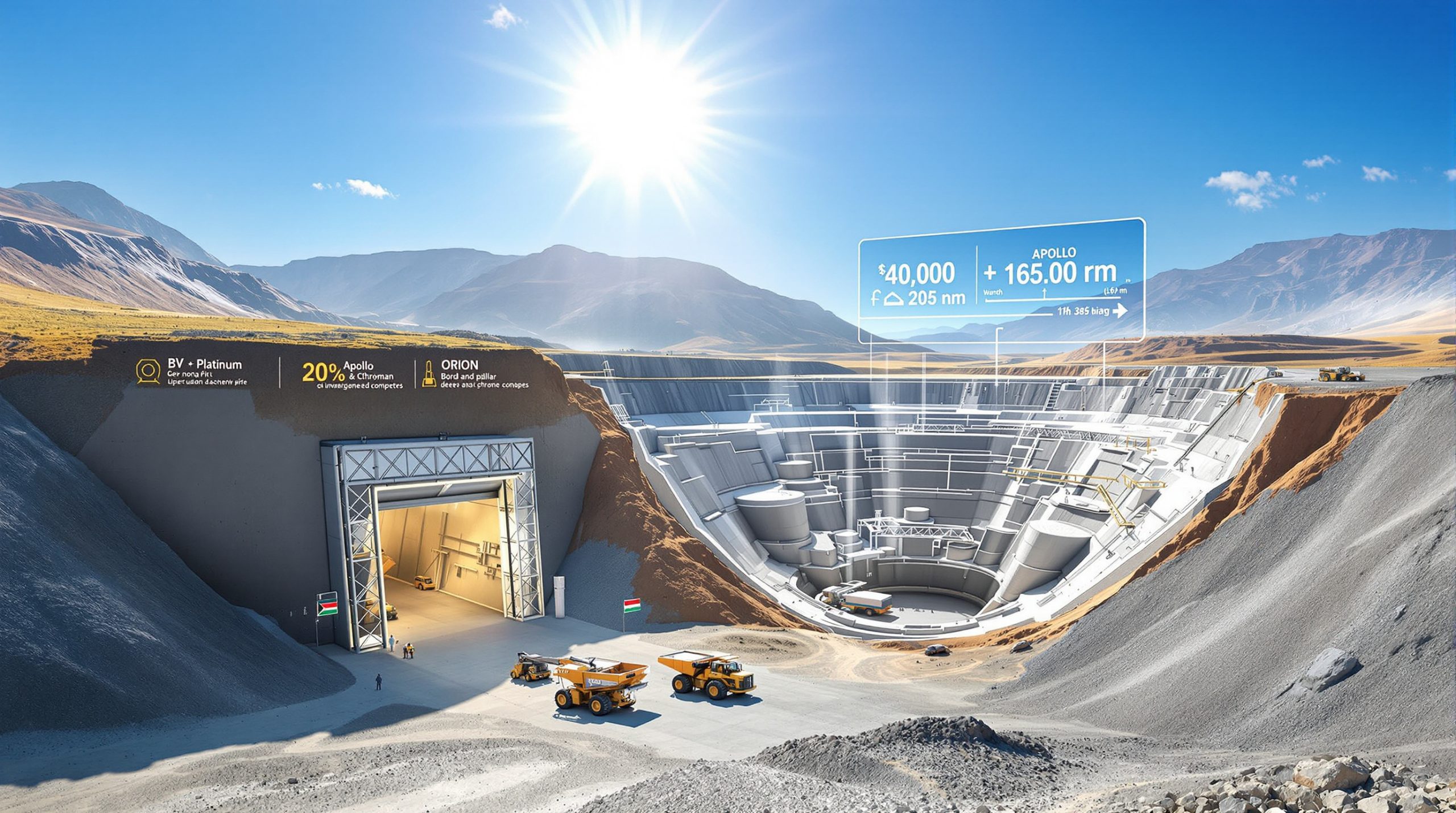Understanding the Silver Market Deficit: Causes, Impacts, and Future Outlook
The silver market has entered its fifth consecutive year of structural deficit, with demand consistently outpacing available supply. According to recent market analysis, the cumulative supply shortfall from 2021 through 2025 is projected to reach approximately 796 million ounces—nearly equivalent to an entire year of global silver mine production. This persistent imbalance has contributed to silver prices reaching multi-year highs, trading above $48/oz in early October 2025.
What Is Driving the Current Silver Market Deficit?
The Growing Supply-Demand Imbalance
The silver market deficit represents a fundamental shift in global commodity dynamics. This ongoing imbalance between production and consumption has persisted for an unprecedented five consecutive years, signaling a structural rather than cyclical issue. Market analysts note that this prolonged deficit pattern differs significantly from historical silver market cycles, which typically experienced shorter periods of imbalance.
The deficit has been steadily widening, with 2024 showing the largest annual gap between supply and demand. This persistent supply deficits drivers has reduced above-ground inventories to levels that are creating concern among industrial users and investors alike.
Industrial Demand Reaching Record Levels
Industrial fabrication has emerged as the primary driver behind silver's growing deficit, reaching an all-time high in 2024. This surge in demand stems from several key sectors:
-
Renewable Energy Applications: The photovoltaic (solar) sector continues to be the single largest growth engine for industrial silver demand. A typical crystalline silicon solar panel contains approximately 20 grams of silver, and global solar installations continue to accelerate as countries pursue renewable energy targets.
-
Automotive Industry Transformation: The electrification of transportation has dramatically increased silver usage, with electric vehicles requiring substantially more silver than conventional vehicles. An average EV contains 25-50 grams of silver, compared to 15-28 grams in traditional vehicles, due to additional electronic systems and battery management components.
-
Advanced Electronics: The expansion of 5G infrastructure and AI-related consumer electronics has created additional demand pressure. Silver's superior electrical conductivity makes it irreplaceable in high-performance electronic components.
The combined effect of these industrial applications has created sustained demand growth that outpaces supply expansion capabilities. This industrial demand is particularly significant because it represents relatively price-inelastic consumption—these applications require silver regardless of minor to moderate price fluctuations.
Supply Constraints and Challenges
While demand continues to accelerate, silver supply growth remains sluggish due to several structural limitations:
-
Limited Mine Production Growth: Global silver mine output has shown only modest increases in 2024, insufficient to match the pace of demand growth. Mining companies have increased capital expenditures by approximately 40% in 2024-2025, but the long lead times for new mine development mean production increases will not materialize until the late 2020s.
-
Byproduct Mining Dynamics: Approximately 75% of silver production comes as a byproduct of mining other metals, primarily copper, lead, and zinc. This byproduct relationship means that silver supply responds more to the economics of base metal mining than to silver market fundamentals.
-
Resource Depletion: Many established silver mining regions are experiencing declining ore grades. Average grades have fallen from approximately 150 grams per tonne in 2010 to under 100 grams per tonne in recent years, requiring increased mining and processing volumes to maintain equivalent production levels.
-
Development Timeline Challenges: New silver mines typically require 8-9 years from discovery to production, creating significant lead times for supply responses to current price signals. Environmental regulations and permitting processes in many jurisdictions have extended these timelines beyond historical averages.
These supply constraints create a fundamental mismatch with the rapidly accelerating demand trajectory, contributing to the persistent deficit situation.
How Is the Silver Deficit Affecting Market Dynamics?
Price Response and Market Signals
The persistent deficit has created notable market responses across multiple indicators:
-
Multi-Year Price Highs: Silver prices have reached levels not seen in years, trading above $48/oz in early October 2025. This price movement reflects genuine supply-demand fundamentals rather than speculative positioning.
-
Inventory Drawdowns: Above-ground stockpiles have decreased significantly as the market attempts to fill the supply gap. This inventory reduction has accelerated in recent quarters as industrial users increase strategic stockpiling.
-
Market Tightness Indicators: Physical silver availability metrics show increasing signs of scarcity. Rising silver market premiums for physical silver over spot prices, particularly in retail investment products, have become more prevalent. Some forms of physical silver are experiencing periodic scarcity in certain regional markets.
The price response has been particularly notable given the size of the silver market, which at approximately $25-30 billion annually remains relatively small compared to other commodity markets. This limited market size contributes to higher price volatility and greater sensitivity to changes in supply or demand patterns.
Investment Demand Resurgence
After a period of reduced activity in Western markets, investor interest has shown a notable resurgence in 2025:
-
ETF Inflows Reversal: Silver-backed ETFs have experienced positive inflows in 2025, reversing the outflows observed during the previous two years. The iShares Silver Trust (SLV) and similar vehicles have reported significant increases in holdings.
-
Macroeconomic Tailwinds: Anticipated U.S. Federal Reserve interest rate cuts have created a supportive environment for precious metals. Investors increasingly view silver as a portfolio diversification asset with both industrial and monetary characteristics.
-
Strategic Positioning: Investors are increasingly viewing silver as both an industrial metal with strong fundamentals and a monetary metal with potential upside. This dual perception has broadened the investor base beyond traditional precious metals enthusiasts.
Regional variations in investment demand have become more pronounced, with Asian markets showing particular strength. Physical silver dealers report increased premiums for coins and bars, with some products commanding premiums of 15-25% above spot prices compared to historical averages of 5-10%.
What Are the Long-Term Implications of the Silver Deficit?
Structural Market Transformation
The ongoing deficit represents a fundamental shift in silver market dynamics with several long-term implications:
-
Supply Response Challenges: The development timeline for new silver mines averages 8-9 years from discovery to production, creating significant lead times for supply responses. Even with sustained higher prices, meaningful production increases will take years to materialize.
-
Industrial Demand Resilience: Key growth sectors like renewable energy and vehicle electrification are expected to maintain strong demand trajectories. The International Energy Agency projects that global solar photovoltaic capacity will need to triple by 2030 to meet climate targets, suggesting continued strong industrial demand growth.
-
Inventory Depletion Concerns: Continued drawdowns of above-ground stocks could eventually create acute physical shortages. Unlike gold, which has substantial above-ground inventories, silver's industrial consumption has historically limited stockpile accumulation.
The structural nature of the current deficit differs markedly from historical cyclical shortages. The persistent five-year duration of supply shortfalls represents an unprecedented situation in modern silver markets, requiring fundamental adjustments from market participants.
Price Discovery and Market Valuation
The persistent deficit has implications for how silver is valued in the marketplace:
-
Gold-Silver Ratio Adjustments: The historical price relationship between gold and silver may undergo recalibration as industrial demand becomes increasingly dominant. The gold-silver ratio has shown increased volatility as silver's industrial characteristics become more prominent relative to its monetary metal properties.
-
Production Cost Considerations: With all-in sustaining costs averaging around $20/oz for primary silver miners, current prices provide strong profit margins. These improved economics are enabling mining companies to develop previously marginal projects, though with significant time lags.
-
Investment Premium Development: The combination of industrial necessity and monetary characteristics could establish a new investment premium for silver. Investors are increasingly recognizing silver's unique position at the intersection of industrial necessity and precious metal store of value.
Market analysts observe that current price levels reflect genuine supply-demand fundamentals rather than speculative positioning. This fundamental underpinning suggests a more sustainable price structure compared to historically volatile silver markets.
What Factors Could Alleviate or Exacerbate the Silver Deficit?
Potential Supply Expansion Pathways
Several factors could potentially increase silver supply, though each faces significant limitations:
-
Price-Driven Exploration: Sustained higher prices may accelerate exploration and development of primary silver projects. Mining companies have increased capital expenditures by approximately 40% in 2024-2025 compared to previous years, indicating industry response to improved price conditions.
-
Recycling Improvements: Enhanced recovery technologies could increase the contribution from recycled silver. Silver recycling currently provides approximately 15-20% of global supply, with technological improvements potentially increasing recovery rates from current levels of 70-80% for many applications to above 90%.
-
Byproduct Production Increases: Expansion of base metal mining operations could indirectly boost silver output. Copper mine development projects currently in planning stages could add 50-100 million ounces annually of byproduct silver production if fully developed.
Despite these potential supply expansion pathways, the long lead times for mining development and the relatively fixed nature of byproduct production suggest that supply constraints will persist for several years even under optimistic scenarios.
Demand Evolution Scenarios
The demand side of the equation remains dynamic and could evolve in several ways:
-
Technological Efficiency Gains: Ongoing efforts to reduce silver content per unit in solar panels and electronics could moderate demand growth. Solar panel manufacturers have achieved 20-30% reductions in silver content per panel over the past five years through improved printing techniques and alternative bus bar designs.
-
Substitution Pressures: Very high silver prices might accelerate substitution efforts in some applications. In electrical contacts and high-performance electronics, silver's unique properties make substitution extremely difficult without performance compromises. However, in some photovoltaic applications, alternative materials like copper or aluminum could potentially replace silver at significantly higher price levels.
-
Economic Cycle Sensitivity: Industrial demand has some correlation with broader economic conditions. A significant global economic downturn could temporarily reduce industrial consumption, though structural growth drivers like renewable energy deployment would likely persist through cyclical fluctuations.
The balance of these supply and demand factors will determine the trajectory of the silver market deficit in coming years. Current projections suggest that demand growth will continue to outpace supply expansion, maintaining the structural deficit for the foreseeable future.
FAQ: Understanding the Silver Market Deficit
What defines a silver market deficit?
A silver market deficit occurs when total global demand for silver exceeds the available supply from mining production and recycling, resulting in a drawdown of existing inventories. The current deficit has persisted for five consecutive years, indicating a structural rather than cyclical imbalance.
Historical silver deficits typically lasted 1-2 years and involved significantly smaller cumulative shortfalls than the current five-year deficit totaling 796 million ounces. This extended duration highlights the fundamental nature of the current silver market squeeze.
How does silver's dual role affect market dynamics?
Silver functions both as an industrial metal (with practical applications in manufacturing) and as a precious metal (with monetary characteristics similar to gold). This dual nature means silver responds to both industrial demand factors and investment sentiment, creating complex market dynamics.
Industrial demand accounts for approximately 50-60% of total silver consumption, with jewelry representing 20-25% and investment demand varying between 15-30% depending on market conditions. This demand distribution differs significantly from gold, where investment and central bank demand play larger roles.
The industrial applications provide a floor level of demand that persists regardless of investment sentiment, while the monetary characteristics create potential for investment demand surges during periods of economic uncertainty.
Why can't mining companies simply increase production quickly?
Silver mining faces several constraints that prevent rapid supply expansion:
- Long development timelines for new mines (typically 8-9 years)
- The majority of silver coming as a byproduct of other metal mining
- Declining ore grades in established mining districts
- Regulatory and permitting challenges in many jurisdictions
Primary silver mining projects require substantial capital investment, typically ranging from $100-500 million for major deposits, creating financial barriers to rapid supply expansion. Even with improved economics at current price levels, the lead time for bringing new production online creates an inherent supply response lag.
How does the silver deficit compare to historical patterns?
While silver has experienced periodic deficits throughout its history, the current situation is notable for its persistence (five consecutive years) and magnitude (approaching 800 million ounces cumulatively). Previous deficits were typically shorter-lived and smaller in scale.
Previous silver market disruptions, such as the Hunt Brothers' attempted corner of the silver market in 1979-1980, demonstrate the metal's susceptibility to supply-demand imbalances and resulting price volatility. The current deficit, however, is driven by structural industrial demand rather than speculative positioning.
Central bank silver holdings, while historically significant, have decreased substantially over recent decades as countries have sold strategic stockpiles. This reduction in official sector inventory provides less of a supply buffer during deficit periods compared to gold markets.
Future Outlook for the Silver Market
Short-Term Market Projections
The immediate outlook for the silver market suggests continued tightness:
-
Persistent Deficit Conditions: Supply-demand imbalances are expected to continue through at least 2025. Industry forecasters suggest that the structural deficit could persist through the remainder of the decade unless significant supply additions or demand reductions occur.
-
Price Volatility: Periods of significant price movement are likely as the market adjusts to structural changes. Silver's relatively small market size contributes to potential volatility during periods of changing market sentiment.
-
Physical Availability Challenges: Certain forms of physical silver may experience periodic scarcity. Regional variations in physical silver availability have become more pronounced, with Asian markets showing particular tightness during peak industrial demand periods.
The energy transition timeline, driven by climate commitments and policy support, suggests continued strong industrial demand growth that may outpace supply development in the near term.
Long-Term Market Evolution
Looking further ahead, several key trends may shape the silver market:
-
Energy Transition Acceleration: The global push toward renewable energy and electrification will continue to support industrial demand. Electric vehicle sales are projected to reach 30% of total vehicle sales by 2030, representing a significant expansion of automotive silver demand.
-
Mining Industry Adaptation: The primary silver mining sector may expand in response to sustained higher prices. Current capital investment increases will begin to yield production increases in the late 2020s, potentially beginning to address the structural deficit.
-
Investment Sector Repositioning: Silver's perception among investors may evolve as its industrial importance grows. Investment analysts increasingly view silver as having evolved from primarily a precious metal to a critical industrial metal with precious metal characteristics.
Government policies supporting renewable energy deployment continue to expand globally, with programs like the U.S. Inflation Reduction Act and European Green Deal providing funding for solar installations that will drive silver demand. Meanwhile, the impact of potential silver tariffs impact on prices remains a concern for market participants.
Strategic Considerations for Market Participants
Different stakeholders face varying implications from the ongoing deficit:
-
Industrial Users: Securing long-term supply agreements and exploring efficiency improvements become increasingly important. Major technology companies have established silver supply agreements to ensure availability for critical applications.
-
Mining Companies: Balancing expansion opportunities against capital discipline presents strategic challenges. Several major mining companies have announced primary silver project developments in response to higher prices.
-
Investors: Evaluating silver's potential role in portfolios given its changing market dynamics requires updated analysis frameworks. The metal's unique position at the intersection of industrial necessity and precious metal store of value offers both opportunities and risks.
The development of silver futures markets and derivative instruments has increased market liquidity but may also contribute to price volatility as financial participants interact with industrial and investment demand.
Conclusion: A Market in Transition
The silver market is experiencing a fundamental transformation driven by the persistent supply deficit. The combination of accelerating industrial demand, particularly from growth sectors like renewable energy and vehicle electrification, alongside constrained supply growth has created a structural imbalance that may take years to resolve.
This deficit represents both challenges and opportunities for various market participants. For industrial users, ensuring supply security becomes increasingly important. For mining companies, the strong price environment provides incentives for expansion while requiring careful capital allocation. For investors, understanding silver prices strategies becomes essential for navigating this evolving landscape.
As the market continues to adapt to these changing dynamics, the silver deficit remains a central factor shaping price discovery, investment flows, and strategic planning across the silver value chain. The structural nature of the current imbalance suggests that market participants will need to adjust to a new paradigm rather than expecting a quick return to historical patterns.
Further Exploration:
Readers interested in learning more about the silver market can explore related educational content from The Silver Institute, which publishes the annual World Silver Survey examining global silver supply and demand trends.
Want to Profit from the Next Major Mineral Discovery?
Discovery Alert's proprietary Discovery IQ model provides real-time notifications when significant mineral discoveries are announced on the ASX, giving investors a crucial market advantage. Visit our discoveries page to see how historic mineral discoveries have generated exceptional returns and begin your 30-day free trial today.




